
Spring Salmon Blog
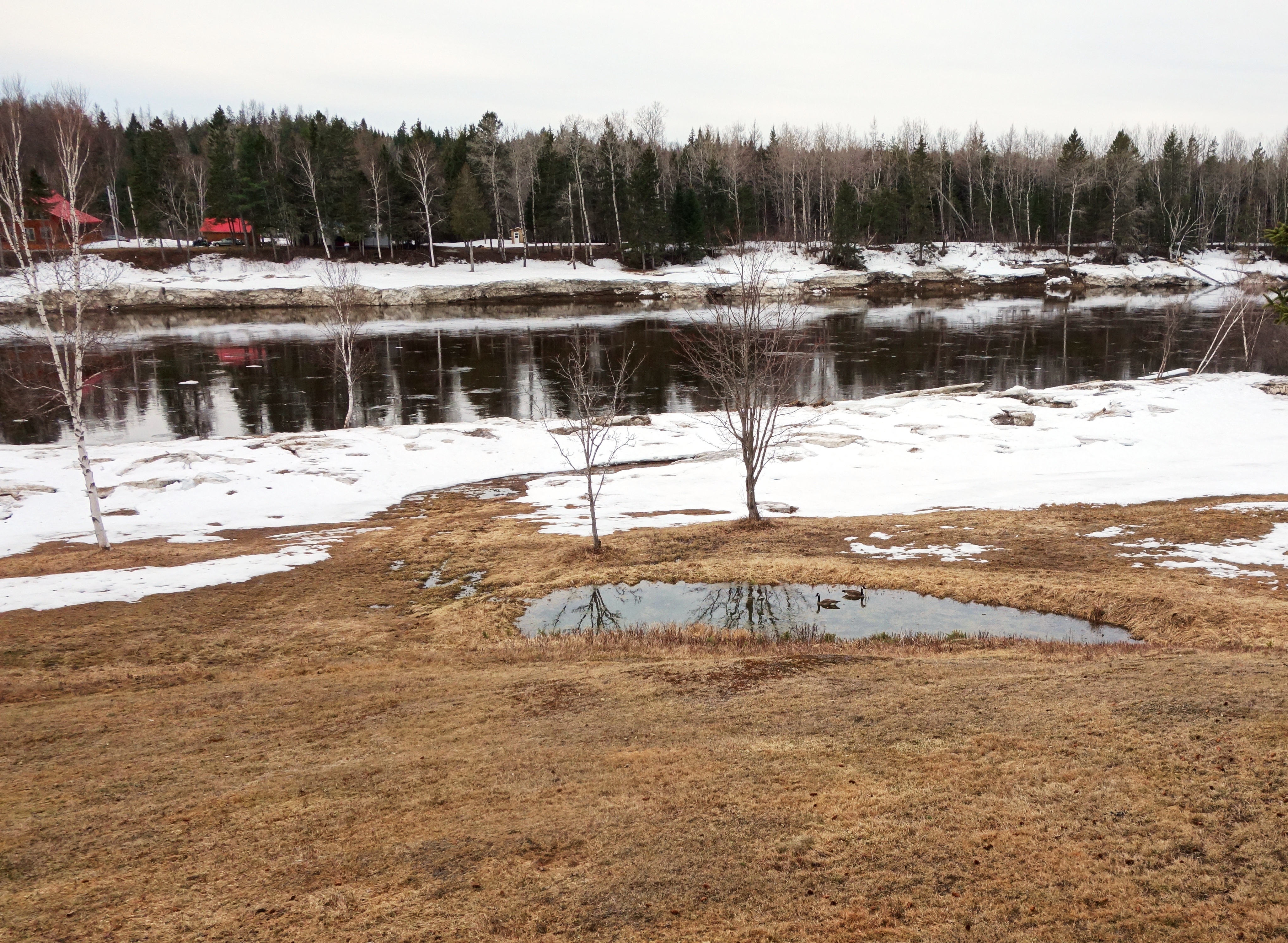
A pair of geese enjoy one of the few snow free spots in Blackville on 4/25/18. Look at the wall of ice across the Miramichi.

Deer seemed to make it through fairly well. I saw them around everywhere. The ones I saw beside 295 in Maine actually looked thinner.
The weather and fishing – Spring has finally come to the Miramichi valley. As those of you living in the Northeast know, it was a crazy winter. We had a snow cover in coastal Maine from virtually the first of December until well into April. They still have it in parts of inland Maine. One true Blackville gray beard told me that it was the most snow he had seen in the woods this late in the season during his 80 or so years. When I left Blackville yesterday I was still scraping the belly of my truck on snow as I drove out of the driveway.
It wasn’t cold all the time, though, and a warm-up during January combined with significant rain caused the Miramichi to rise enough to break loose and run. The thick ice, though, could not get out of the river, and it piled up here and there on the banks and then refroze. Last Wed. 4/25 Jason Curtis took us almost 30 miles up the Cains River, and in the afternoon we went downriver to Doctor’s Island. The evidence of big ice pileups was everywhere.
The area of the river near Campbell’s Pool had ice stacked up and bizarrely refrozen along the banks at least 15 feet high, perhaps higher in places. There was nowhere along the river where you could actually keep a boat. Over this past weekend the water rose 15 feet with rain and snow melt. All night long you could hear the crashing of ice falling back into the river. The river was clearing up by yesterday afternoon, but it would still have been dangerous to be out in the river in a boat.
There have been very few points in time since the season opened two weeks ago when you could really fish for spring salmon because of either floating ice or high, dirty water. In spite of this some decent catches have been made during the windows of opportunity. Eddie Colford, head guide at Black Brook is holding a large kelt taken by angler Rip Cunningham. Rip told me that the fish jumped clear of the water several times and peeled off a bunch of backing. Byron Coughlin said that they had a couple of days when everyone at Country Haven caught fish. Then the raises came and dirtied things up.
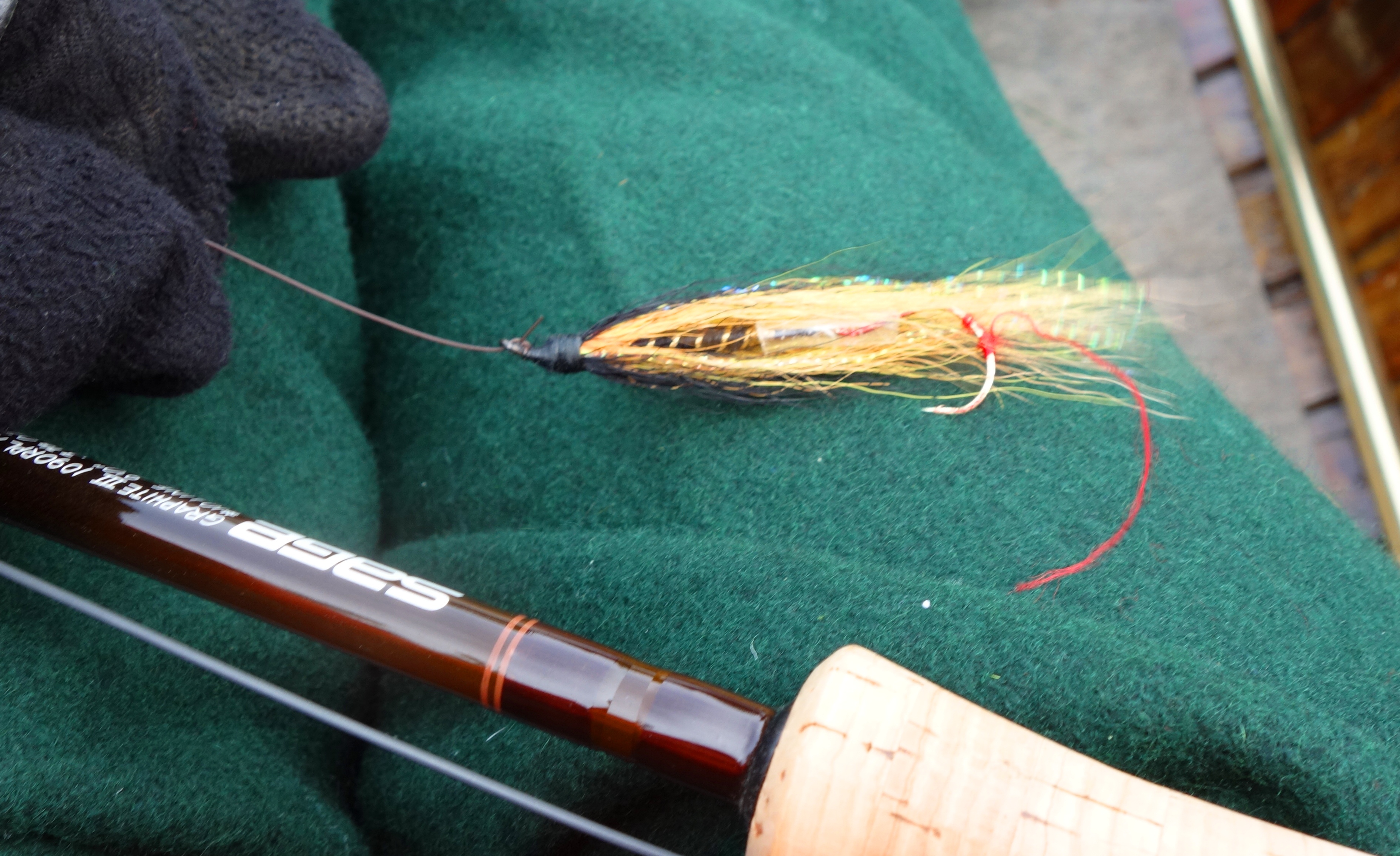
A well chewed Willie Gunn Waddington. A great kelt – spring salmon – fly. Photographed against a pair of Northland green, wool pants I’ve had since college.
New season regulations
Salmon regulations will stay the same as recent years – no retention. With both branches of the Miramichi hosting far less salmon than required to properly seed the river how could we expect to be able to harvest any.
Striped bass regulations have been opened up some with a three fish bag limit – still, though, a very tight slot limit – and a reduced area closure for spawning. There is also talk from those who should know that there will be a commercial harvest by First Nations. To me not allowing all striped bass of any size caught to be retained above the head of tide is hard to defend. If a striped bass is caught upriver where it is assumedly feeding on parr it should be removed regardless of size.
We hear that one reluctance to loosen striped bass regulations is that the NW Miramichi is the only striped bass spawning area north of Nova Scotia. It is a meaningless argument. That is the biology of striped bass. They don’t spawn in every nook and cranny. On the upper half of the East Coast of the United States the only spawning areas of any magnitude are Chesapeake Bay, the Delaware River, and the Hudson River. Striped bass are incredibly fecund, and if they spawned in nearly every river along the coast like gasperaux – river herring – there would be no living fish but striped bass in the entire coastal zone.
We hear that brook trout numbers are down substantially, gasperaux and shad populations are way off, the once fantastically abundant smelt population of the Miramichi that many creatures depend on has declined to a remnant. I guess that at least the new regulations are steps in the right direction, but they probably aren’t nearly enough to bring the striped bass population back into balance with other species in the Miramichi River. You can read more about the new striper regs here at the MSA site.
Winter Projects wrapping up
I spent the winter busier in many ways than I wanted to be. I had two big projects. The first was my new book On the Cains: Atlantic Salmon and Sea-Run Brook Trout on the Miramichi’s Greatest Tributary. It will be published sometime next winter by Stackpole Books. I’ve enjoyed the research and the writing greatly, but everything for the book has needed to be researched, and it has demanded a ton of time and concentration. I still have interviews to do and leads for information and photos to run down. I already have written the minimum text for the book, but still have a full chapter to go and other information to add. It should all be done by the end of July. The plan called for about 120 illustrations and photos. I have over 200 already put together and new ones just keep coming in. Hopefully my editor and publisher will let us expand the size of the book a little.
Here is a small example of the information that I have come across. In 1919 Lee Sturges, self-published a small book about a fishing trip a few years earlier with W. Harry Allen down the Cains River. Lee mentions camping and fishing at the Arbeau Pool. 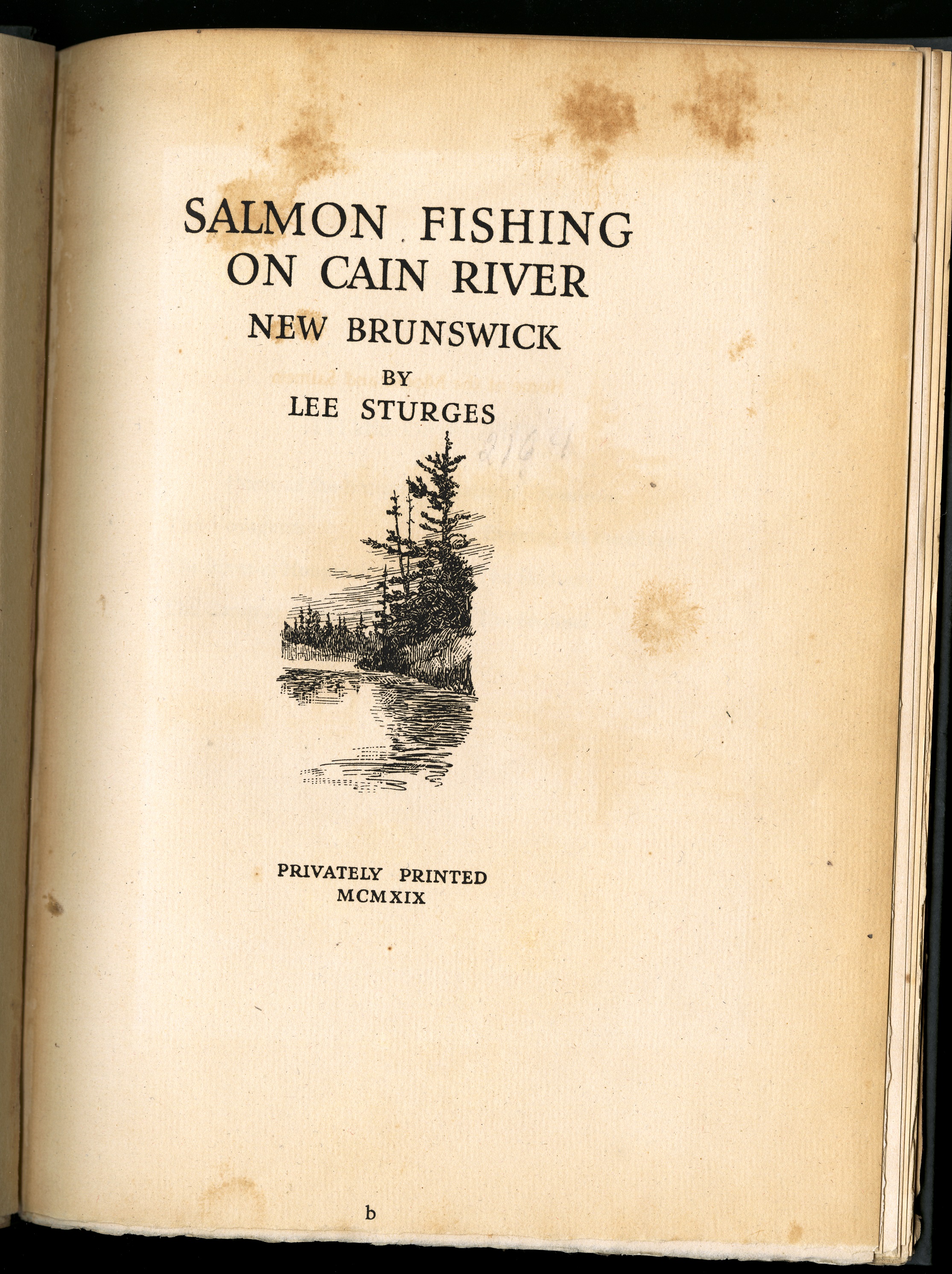 He also drew a picture and made an etching of the long-abandoned, but still standing, farmhouse.
He also drew a picture and made an etching of the long-abandoned, but still standing, farmhouse. 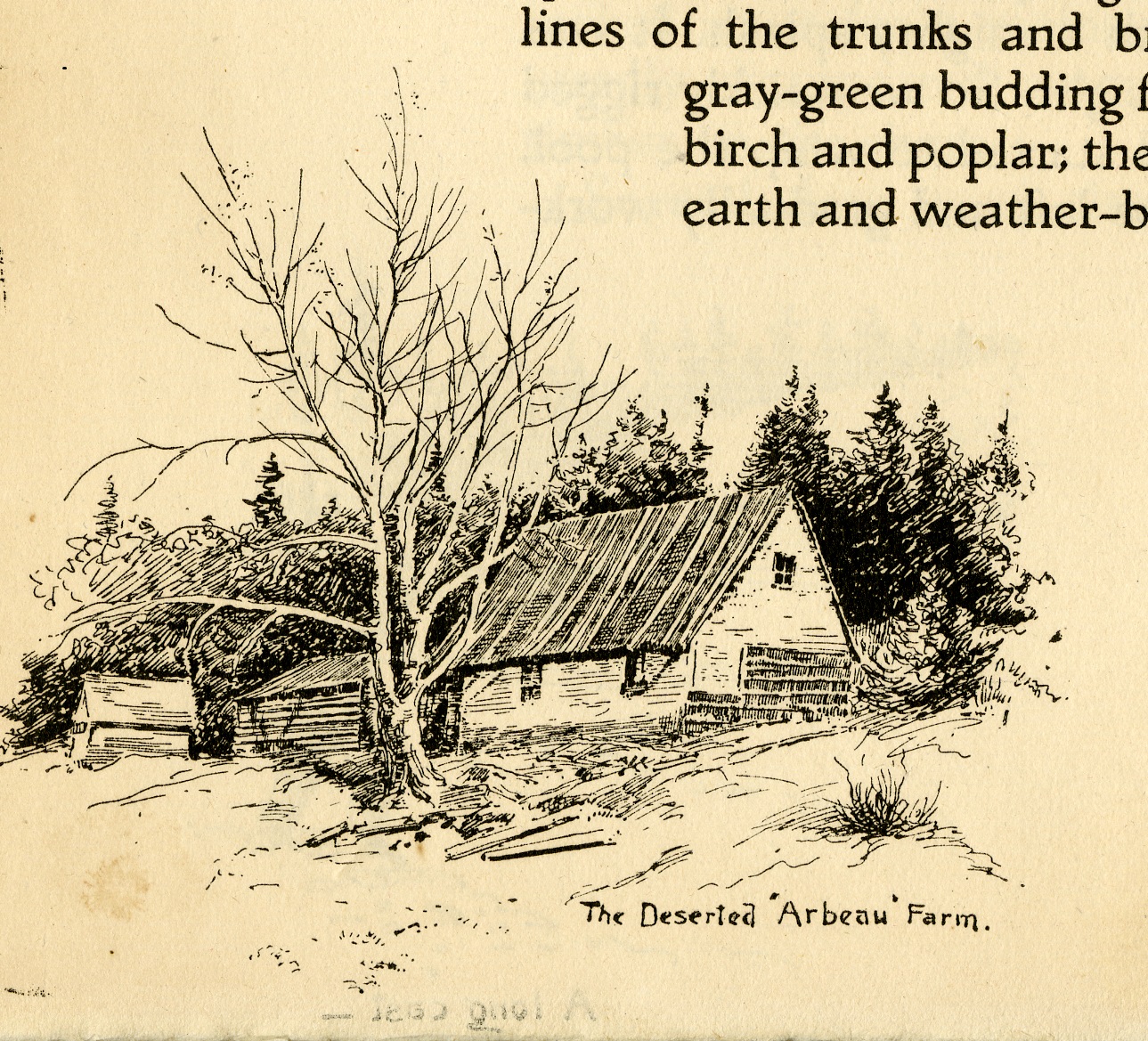 In early writing the pool was quite famous, and virtually everything that you read about the Cains mentions the Arbeau Pool. There are definitely people today who know this pool, but not very many. The pool is not listed in any of the Department of Natural Resources pool maps, and everyone who told me where it was gave me a somewhat different answer.
In early writing the pool was quite famous, and virtually everything that you read about the Cains mentions the Arbeau Pool. There are definitely people today who know this pool, but not very many. The pool is not listed in any of the Department of Natural Resources pool maps, and everyone who told me where it was gave me a somewhat different answer.
I ended up piecing the location together from some hundred year old writing by W. F. Ganong, verbal instructions from Emery Brophy who lumbered there as a teenager more than 60 years ago, from its relative location to the ancient Indian portage route to the Saint John via the Gasperaux that a group of dedicated New Brunswicker canoeing enthusiasts have marked off, and from help with LIDAR technology mapping by Duane Mercer of Natural Resources. I’ll get into all the details in the book, but here some recent photographs and Sturges drawings. Keith Wilson says that the foundation rocks of the farmhouse are just on the downriver side of the stream you see pictured, and up against the trees on the higher ground. That agrees with the maps, but when I tried to walk back there I ran into waist deep snow. I’ll be back and find it this summer.
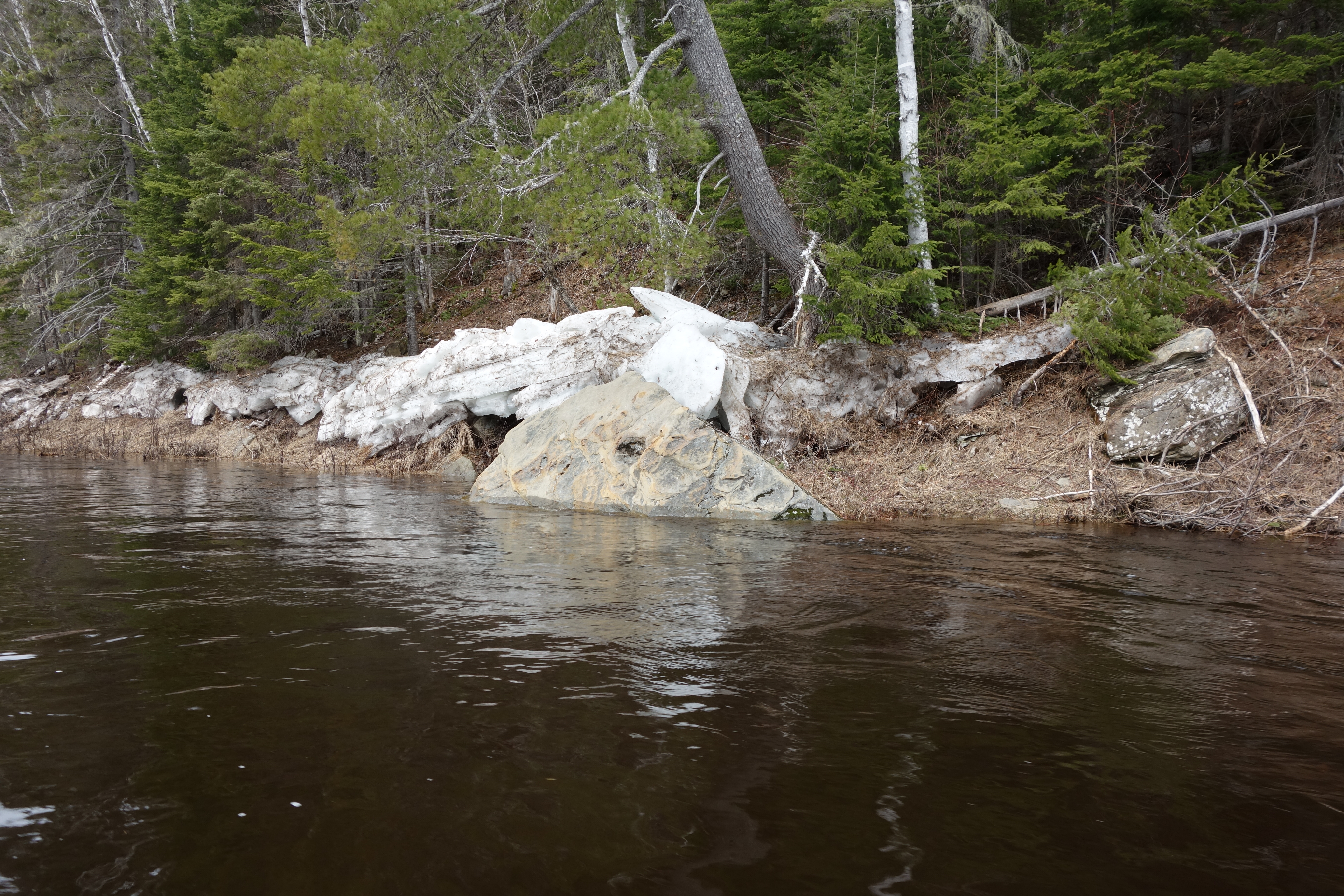
Portage Rock from coming up river. The rock signaled to the Indians and early settlers that the portage trail exited to the left just a short distance upstream.
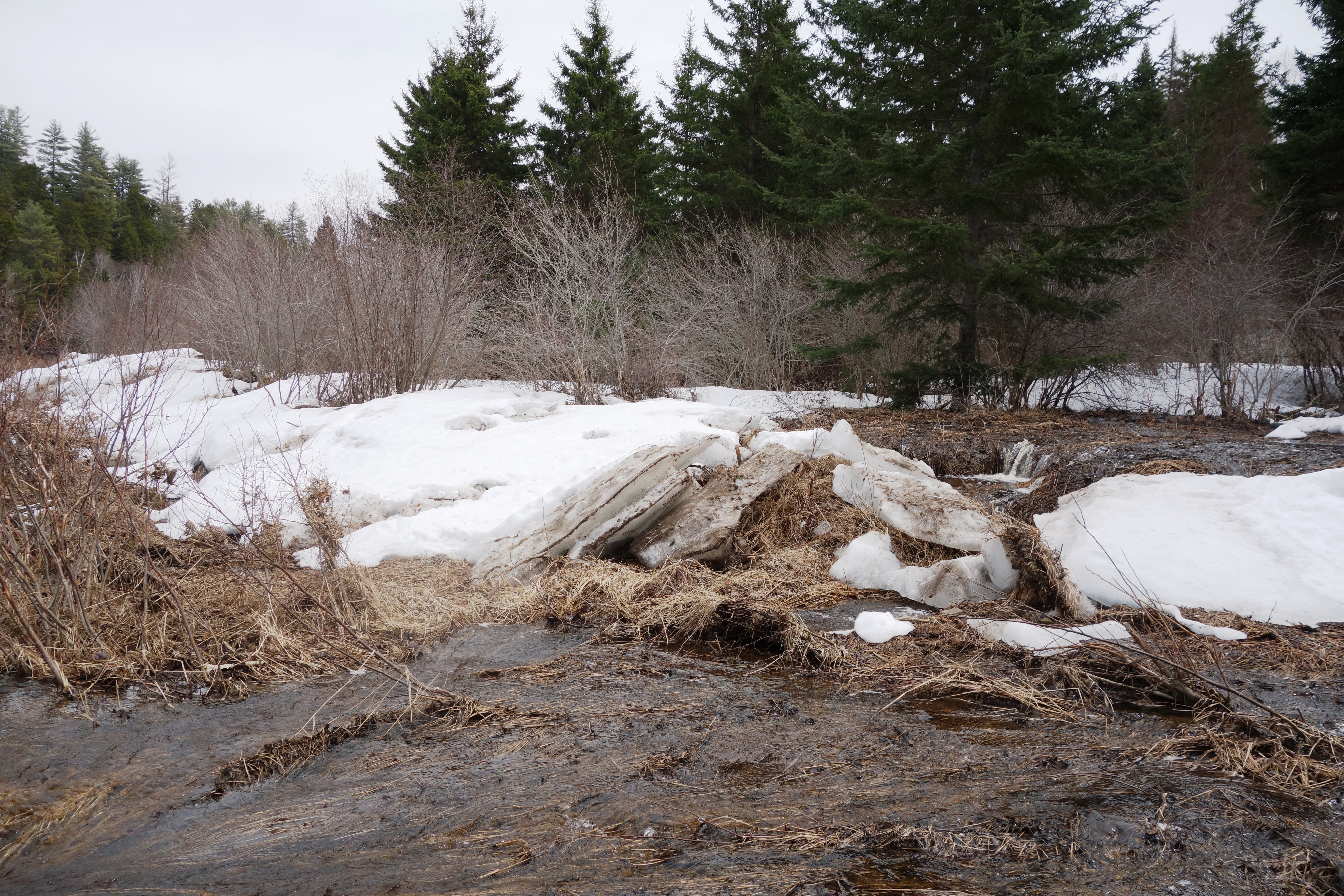
The Arbeau farmhouse drawn above by Sturges stood just across this intervale as the ground started to rise. The low, level ground was all cleared for livestock grazing as it appears in the Sturges drawing.
The other project was the rebuilding of a 20’ v-stern Chestnut Ogilvy fishing canoe. My brother Jason – the real craftsman between us – and I have countless hours in this project, but loved almost every minute of it. I posted a lot of details about the work on my bradburnsflyfishing facebook page. The boat will be heading up to Mahoney Brook on the Cains later on this summer. I’m going to pole it up to the Arbeau Pool.


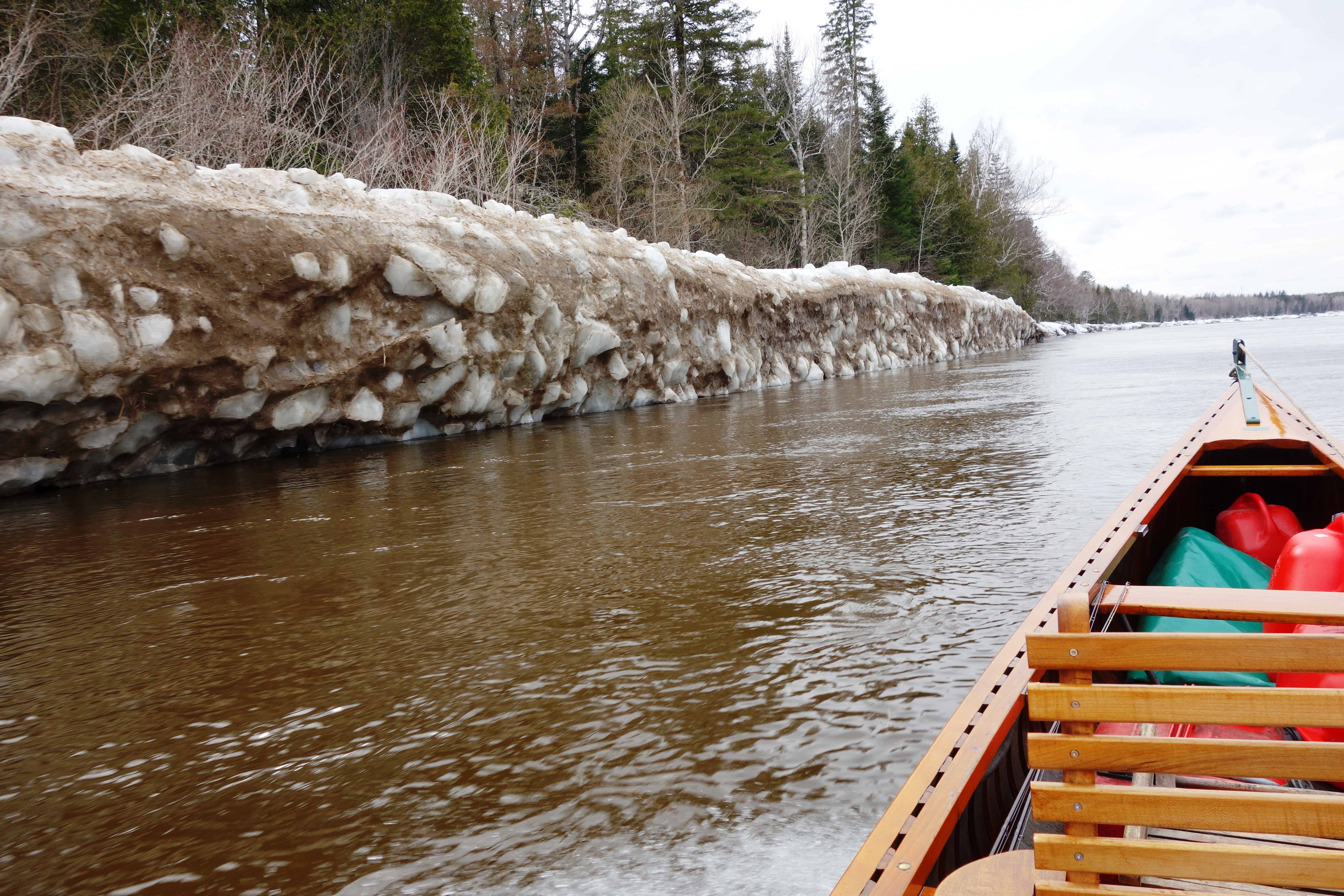
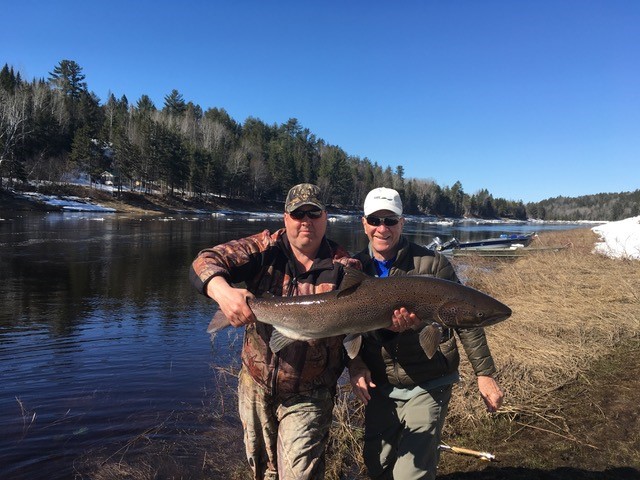
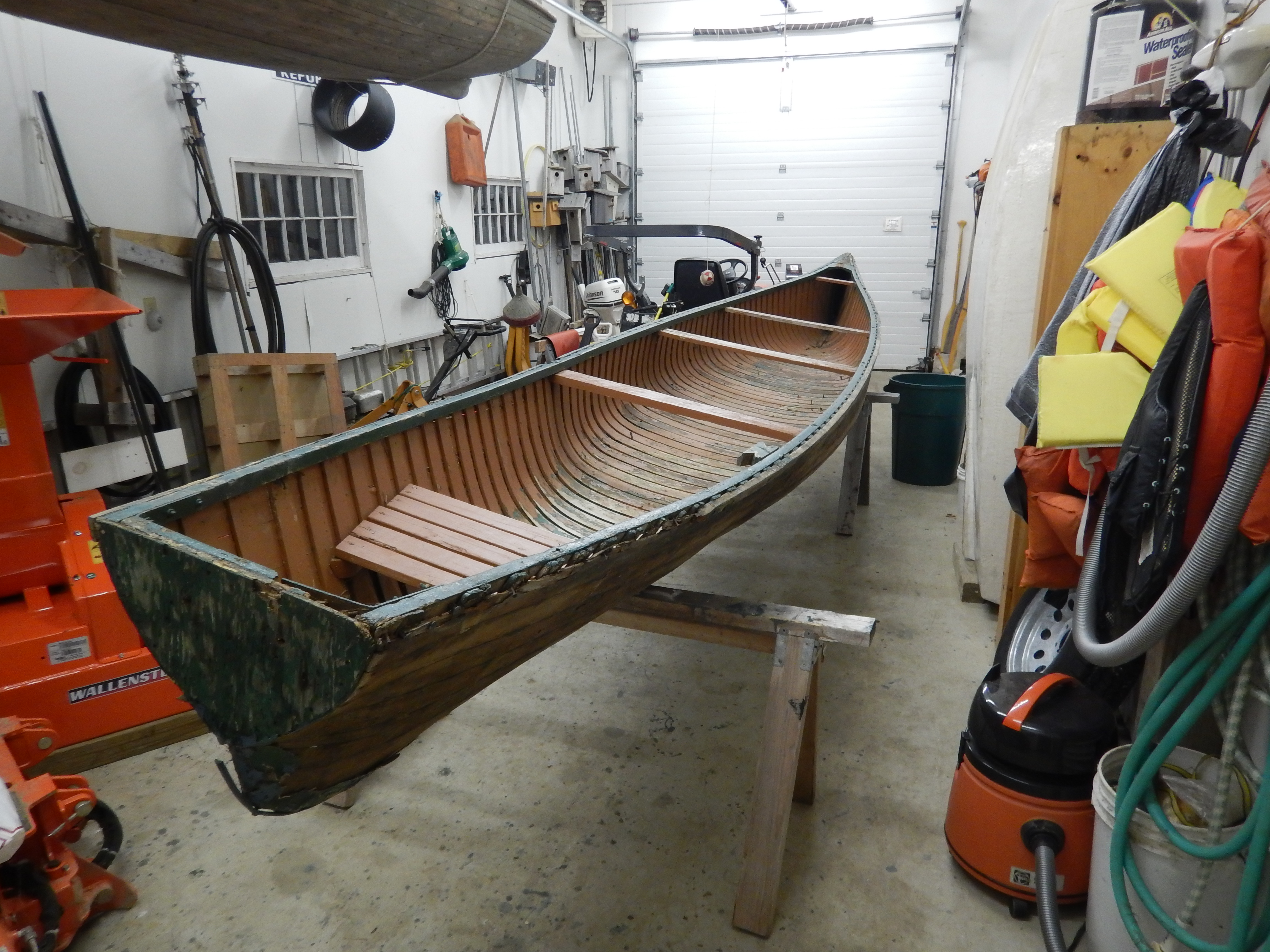
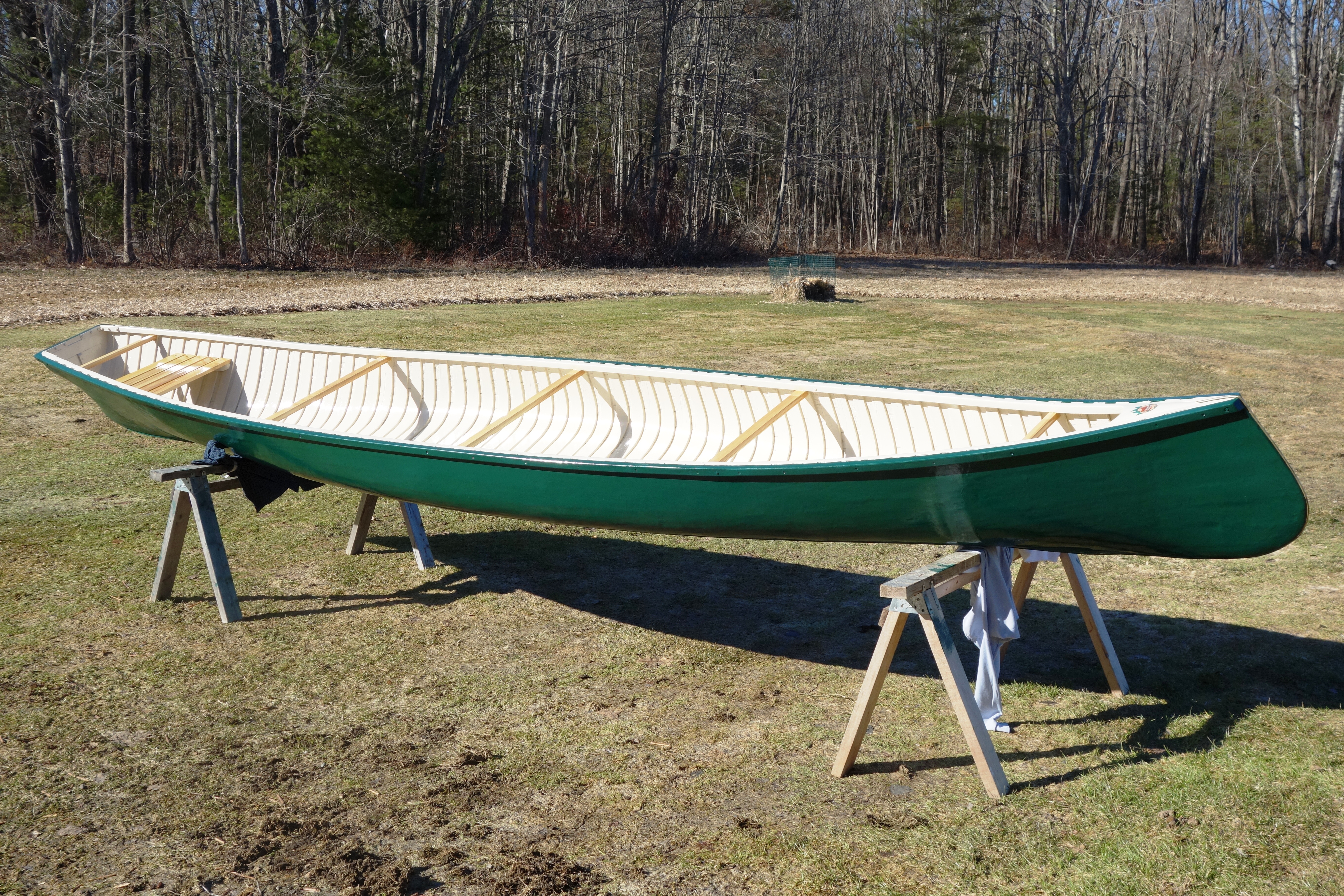
Good to hear from you Brad, I always enjoy reading your Salmon blog. Great photo of Rip’ s salmon, one can only imagine what that fish looked like when it first came in from the ocean.
Thanks Kal. Cold here in Maine again tonight, but supposed to be 80F in a couple of days. Let’s hope the summer is not too hot. Brad
Can’t wait,can’t wait,can’t wait…….
Great report and pics Brad. Been a loooong winter. Ice here in lower Sebago bay just went out. Cabin fever is starting to fade. Time to cast to Sebago Salmo Salar.
Good to hear from you Charlie. I thought it was a long winter down here too, but it is all relative. Blackville had it a lot worse and for a lot longer…
Thanks Brad: This blog makes “spring” a little more tolerable. We have gone from snow flurries last week to rain this week. Rivers in this area out of their banks and our trout season seems distant.
Be well.
JCW
James – thanks. Saw your buddy Gary at the dinner in Boiestown Saturday night. He did a great job and it was a fun evening. Brad
Great read…30 miles of water would have been a nice trip!
Thanks for this informative update, Brad. It’s always fun to read about your adventures and projects. Good for you to be writing about the Cains. Your history will be very valuable in the years to come, I suspect. Glad to read about this!
Hi Brad Great blog as always, including preserving precious history which might otherwise be lost. I assume that the collapse of the Gasperaux and Shad populations will impact on the natural in-river reconditioning of your salmon kelts…………I always assumed with some perplexity, that Striped Bass and Atlantuic Salmon held equal esteem in the Burns book and I’m glad to see that that this hugely depends on whether or not relevant populations are in balance. Which they clearly are not, from what you are explaining here. Slainte. Dave
Dave – Great to hear from you. I recognize that striped bass, Atlantic salmon, and brook trout all are native to the Miramichi River system and have their place. Of these within the Miramichi I think the striped bass are the least understood. The DFO stated recently that the striped bass population tripled within one year from about 350,000 to as many as 1,000,000, but with a very wide possible variance for error. Stripers live a very long time, some upwards of 20 years, and using a 20% natural mortality – the fishing mortality as stripers have been regulated is too small to measure – and just a 10 year life, the year 1 age of a 10 year progression would need to be 14 times the average in size for the population to triple. It seems incredibly unlikely to me. I think it is far more likely that the striped bass population has been much larger for much longer than DFO has previously estimated.
Your analysis of the astonishing DFO estimate seems very logical, Brad. Stripers have been on my lifelong bucket list since first reading Chapter 1 of NF’s wonderful “Going Fishing” (with its wonderful line drawings by Tunnicliffe) as a kid. They seem to be recognised nowadays as having too big a predator base………with those numbers prowling your coastline and estuaries, any puny angling effort on anyone’s part would hardly make a dent!
I hear of concerns that with Mackerel shoals moving northwards to the vicinity of Iceland in unprecedented numbers (presumably in response to oceanic warming), they could well be causing unseen serious impacts on post-smolts arriving there to feed. (When we targeted them off our Scottish harbour walls in our youth, they had no hesitation in smashing a 4-5″ silver Toby, so smolt-sized fish would certainly not be off the menu). What with Goosanders and Cormorants being fingered for almost unsustainably high mortality of in-river migrating smolts, and (on the Dee) the harbour navigation channel being a deadly salmon killing ground for BNDs, Tony Andrews’ past descriptive of our returning adult fish as “Survivors” is becoming more and more apt! But they’re a biologically ancient species of fish and may have seen much worse in the past?
Brad, I look forward to your musings, they always educate and enlighten me. Let’s fish!
All the best,
phil
Brad…I fished the Arbeau pools( there are 3 within a mile) one morning in the second week of October last year. Water was too low, and no fish were seen. Did get one partridge for supper!
Good luck poling up to the Arbeau’s…there are so many beautiful pools between Arbeau and Mahoney, that if you are fishing you will never get there!
Thanks Carl. Actually I suppose I should have clarified that I found the location of the old Arbeau farm. I’m not sure exactly where the pool is located, and it is unlikely that I will get to fish it since as you say we have enough to keep us busy downriver. I found it all quite fascinating though. One commenter said they couldn’t figure out why anyone ever built way out there on their own. I suspect that with the Crown Grant upriver a half mile at Lower Trout Hole that some settlers intended to make a little community out of the area, but it never did work out.
One thing I learned by reading every page of the Camp Stanton catch records from 1938 to 1971 is that now as it was then, the fish simply don’t come up the Cains in the fall until their is a sufficient raise of water. It can be great one fall in the Cains and absolutely nothing during the season the next.
Hello Brad, That was so great!!!! I loved it. I hope you will keep me on your list.
I will always remember my first Atlantic salmon fishing trip. I was invited to the Miramichi Salmon Club in Doaktown, by the man who owned Juniper Lumber–who was a member. I don’t remember his name, but I took John Marsh with me and caught my first Atlantic salmon in Green Rocks Pool. That was about 1987. I caught about 10 in my lifetime–all grilse, but one.
Dick Anderson
Thanks Dick. I believe that Mac Ray who commented earlier is a member of the Miramichi Salmon Club and fishes there quite regularly. I remember Marsh. He is a great man for fishery conservation.
Hello Brad.
Very familar with the Arbeou homestead.
A magical place indeed.
There are 2 pools, a lower and upper.
Also very familar with the many pools all the way to the Hannah pool which is where we ended many sailing trips on Cains river.
Enjoyed your recent book about the Cains.
The Alex Arbeou homestead was one of a handful of settlers on the Cains.
Curran Brook, Mc Cormick and Murray are others downstream which come to mind.
Fished Cains with Ralph Gilks, Hubert & Lyman Gilks many times. (Ralph Gilks, Blissfield)
These great men are all gone.
Thank you very much for your comments Al.
Hello Brad,
Thank you for a spring update. I always enjoy reading your blog. Looking forward with great anticipation to your next book. I am sure it will be both, educational and entertaining.
Hi Bradd, fascinating report on what things are like up there in this most unusual spring. I’ll be up before salmon season to do my part to lower the striper population but right now the best conditions won’t be happening until early June. This years run is going to be a big indicator. Let’s hope and pray we don’t see another dramatic decline. I’d love to be dead wrong about pessimism on the stripers impact.
Bill Jacobus
Amen. Thanks Bill. Brad
Brad i have read a lot of your comments about the Miramichi, however there is one question i have concerning the poor management by DFO and the lack of faith in there calculations of the number of salmon returning to the Miramichi. I have spent the last three years fishing at quarryville and have noticed that the fishing has been as good as the fishing in the 80s and 90s . Some days i was able to catch my quota with in hours. Just wondering if the game of deceit by the feds is there way to control a past time truly loved by this New Brunswicker.
David – I fished Quarryville myself last fall several days during that very low water, and I was very pleased to see the number of fish that were present down there waiting for a raise of water. We know some of the DFO folks involved in the trap counting system, and I am quite convinced that everything that you see with that process is on the up and up. The mark and recapture process is somewhat inexact, no doubt, but it has been consistently done for many years. The trends are undeniably headed in the wrong direction. It may be that a place like Quarryville or even a certain few pools up in the river are doing pretty well at times because conditions are right for them, but on most recent years there are far fewer salmon coming into both branches of the Miramichi than are needed to fully seed the river with eggs. This is supposed to be a minimum target.
When you say that the feds are trying to control your pastime I wonder if you mean that they are not allowing you to take home any grilse to eat? Personally I’m very thankful that we have catch and release fishing to participate in. Like you I truly love the sport, and if this were the good old days I’d by more than happy to be eating some fresh, wild Atlantic salmon. Unfortunately, at this time, I don’t see how any bag limit can be justified. Brad
Brad i have fished the Miramichi since I was fourteen, I am now fifty-nine years old. I have enjoyed the retention days and and know that catch and release is the way of the future. I have carefully released my fish and love the sport. The dramatic decrease in our stock has alarmed the very fibre of this New Brunswick, however I currently support the idea of a grilse retention based on down river net counts done yearly and allowing tags for specific rivers that are supporting adequate quantities of fish. I have been to the counting fences on a number of our rivers and have seen great numbers of fish down river but the numbers published at the counting fence do not accurately assess the true salmon population. The only way to bring back our great fishery is to listen to the people on the river and take the politics out of the equation.
Hi Brad , good to see your going back to the Varzuga. The early signs look promising and let’s hope we can fish the river properly this year .
Hope this fines you well , looking forward to meeting back up with the team .
Jamie Kilgannon… Scotland 🏴
Aye Jamie, good to hear from you. After the spring you’ve had in Scotland you can go to Russia and warm up. I’ll see you in a couple of weeks.
Salmon fishing must be a blast. Catching such a fish on light tackle in shallow water.
Thanks. Interesting and good to know that someone is reading some of the old back blogs. That fish Rip Cunningham caught was certainly a great specimen for early in the year. Brad
Brad: I just stumbled on your page while looking for updates on the Salmon up in Sunny Corner NB. You are really a pleasure to read. I’ve been going up to Sunny Corner since the mid 80’s and always in May so I can give my wife a break for Mothers Day. All I want to do is chase the black salmon. Not everyone’s cup of tea but great for me. Fishing has been ok to great on various occasions but my real joy is the people. Anyways. Just wanted to tell you how much I enjoyed finding your blog. I’ll have to see if I can find it again in the next couple of weeks. I’m not too up to speed on tech.
Thanks Bob. I have added you to my blog notification list, and you will get an e-mail whenever I make a new post.